|
 Secure Site
Secure Site
|
 |
Archive for the 'Well-being' Category
 meditating on a rock According to traditional Chinese medicine (TCM), the heart is the emperor of the body—it feeds all systems and rules the mind. The connection between the mind and the heart is more than just metaphysical: In a 2008 study conducted by researchers at the Medical College of Georgia, adolescents who practiced simple breath-awareness meditation for 20 minutes a day—10 minutes in school and 10 minutes at home—for three months experienced significant reductions in blood pressure and resting heart rate. Laurie Steelsmith, ND, a specialist in TCM and author of Natural Choices for Women’s Health (Three Rivers Press, 2005), recommends meditating 20 minutes a day at least four times a week to reap the full benefits of the practice. Or give your heart a mini-vacation by settling in with your favorite soothing CD. Research shows the heart synchronizes its beating to increases and decreases in music tempo. “We often use classical music to help our patients’ heart rate slow to 60 to 70 beats per minute,” says Michelle Cameron, director of healing solutions at the Cleveland Clinic.
The Digital Zen Clock & Chime Timer serves as a countdown and interval timer for yoga, meditation, bodywork, etc.; and it can also be set to chime on the hour as a tool for “mindfulness.”
Digital Zen Clocks feature a “high” and “low” chime strike volume control, which allows you to adjust the sound of the chime to suit your needs. The Digital Zen Clock runs on 2 AA batteries (not included) and can also be plugged in with the included AC jack. The clock includes a lighted digital display (which can be set to be lit full-time when plugged in).
adapted from Natural Solutions Magazine, January 2010 by Kate Hanley
 Natural Chime Meditation Timers in Solid Maple Now & Zen’s Natural Chime Timer Shop
1638 Pearl Street
Boulder, CO 80302
(800) 779-6383
Posted in intention, Meditation Timers, Meditation Tools, mindfulness practice, nature, Well-being, zen, Zen Timers
 the art and science of a balanced life
The funny thing about balance is that people rarely consider it—until it eludes their grasp.
In both the physical sense and through how we live our lives, balance is often an afterthought. Let’s use standing upright as an example: Typically, the act of standing is so rehearsed, we do not notice how truly amazing this action is. If you watch a child learning to stand, however, or have ever experienced vertigo, you remember that performing this feat is only easy when you have balance.
The act of standing requires the ability to make small corrections, which give the appearance of being centered. When standing still, there is always movement happening; it is a process of give and take.
 Ohara Koson (Shoson). 1877-1945 two carp and white lotus 1933 In physics, balance only occurs when two equal forces are applied in opposite directions. Standing requires movement, but the shifts are small. If you sway a bit to the right, you naturally counter-balance by shifting to the left. It’s these small corrections that keep you centered. Beingout of balance means the correction, or counter-balancing movement, was not effective.
The same is true with life balance. However, many of us fail to make the small corrections in time. Maybe you focus too much on work and now have relationship problems, or spend too much money and are now in debt. Maybe you let your physical fitness go and now face an illness. These big imbalances are very disruptive and can be avoided.
But first, let’s talk about life balance. What is it? Life balance can be identified by feelings such as joy, happiness, confidence, hopefulness, and ease. Life balance is a sense of well-being—and feeling well creates wellness in many ways, such as lowering blood pressure. Achieving balance even improves your ability to manage stress. Remember this if nothing else: Life balance starts with positive feelings. You need to believe you can have the things you want in life, first.
 creativity The art of life balance requires creativity. If you push too hard you will miss its subtle rewards. Navigating easily through life requires a sense of curiosity and playfulness, like that of a child. This doesn’t excuse you from taking life seriously, simply that you release the illusion that you can control everything. By exerting control over everything, you
may end up limiting yourself. The art of life balance requires dedicated time for having fun and observing the world around you. You may be surprised at what you find if you do.
Life balance comes from trust, faith, and fun counter-balanced by logic. The science of life balance can be thought of as your logical side. Typically we think of this as planning and scheduling, but it is much more. The science of balance has been studied for millennia. If you look at the Taoist teachings of yin and yang, for example, you will discover that each side of the familiar symbol includes a small circle of the opposite color at the center. Believing that nothing is totally black or white—right or wrong—can help you perceive circumstances in a new way.
Unsure where to start? Here’s an exercise you can do. Take a moment to write down these categories so you can rate them in a moment:
• Career/School
• Finances
• Health
• Significant Other
• Family Life
• Friends
• Community
• Physical Environment
• Other (list anything else that comes to mind)
Next, rate each area of your life according to your level of satisfaction. If you feel completely satisfied, give yourself a rating of 3. Somewhat satisfied, a 2. And not satisfied, a 1.
Look at the areas you rated as a 1. These are the areas that may be creating imbalance in your life. If you feel sad or overwhelmed, please stop for a moment and take a few full, gentle breaths.
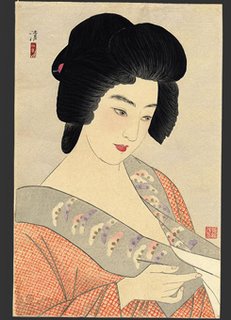 how to find balance in your life The first step to life is creating awareness and the second is centering. You will not create good results in your life if you feel panicked. And remember, creating balance does not mean you have to change anything. Instead maybe take a moment to look at the 3s on your list and feel grateful.
If there are no 3s take a moment to feel grateful anyway. You are here reading this article, which means you are creating an important shift already. Let that be enough for now and enjoy. The important thing to remember is that life balance is a state of ease, so try to connect to these feelings whenever possible. Even if your life feels chaotic, your change begins from within. Close your eyes and visualize the changes you would like to see in your life. This allows you to tap into your creative side. Then open your eyes and start to write down your goals and dreams. When you are ready, come up with a plan to connect these with your logical side. Now that’s balance in action!
Jenny Gallagher is a certified life, wellness and business coach. She is also a registeredyoga teacher and author of Yen Path: Taking Steps Towards What You Want in Life (2011). For more information go to www.jennygallagher.com.
Our Zen Timepiece‘s acoustic 6-inch brass bowl-gong clock is the world’s ultimate alarm clock, practice timer, and “mindfulness bell.”
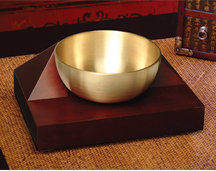 Well-being Chime Alarm Clock and Meditation Timer It fills your environment with beautifully complex tones whenever it strikes. In the morning, its exquisite sounds summon your consciousness into awakening with a series of subtle gongs that provide an elegant beginning to your day. Once you experience the Zen Timepiece’s progressive awakening, you’ll never want to wake up any other way. It also serves as the perfect meditation timer.
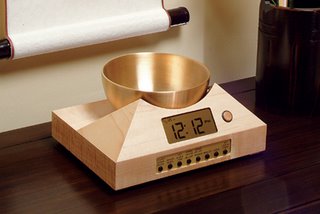 Singing Bowl Alarm Clocks with Real Acoustic Sounds Now & Zen’s Chime Alarm Clock Store
1638 Pearl Street
Boulder, CO 80302
(800) 779-6383
Posted in Meditation Timers, Meditation Tools, mindfulness practice, Well-being
 meditating makes you happier A few years back, the notion that meditation could bring bliss was something only a swami might swallow. Today it’s an idea that rings true to the ever-increasing numbers of people—from Madonna and Tiger Woods to thousands of ordinary Janes and Joes—who are making meditation a part of their everyday lives.
For years, studies have suggested that meditating can ease chronic pain, lower blood pressure, and reduce anxiety. But University of Wisconsin researchers recently broke new ground, uncovering physical evidence that it may actually make us happier.
A group of stressed-out employees at a biotech company was taught mindfulness meditation and was asked to meditate at home for an hour a day, six days a week, for eight weeks. The researchers measured electrical activity in the volunteers’ brains at the beginning and end of the experiment, and again four months later.
Those who meditated had more activity in the area of their brains linked to positive emotions. “These people weren’t meditating for thousands of hours like monks do,” says Saki Santorelli, executive director of the Center for Mindfulness at the University of Massachusetts Medical School in Worcester and one of the study’s coauthors. “The study suggests that everyday people are capable of altering their brain function in a positive direction.”
The next step on the research agenda, says Santorelli, is to better define and measure just what mindfulness is, so as to understand more about how it affects the mind and body. Scientists are also looking at how meditation might help some serious conditions, including prostate cancer, asthma, and menopausal symptoms.
What you can do: All it takes to reset your stress-o-meter is ten minutes a day of quiet. To start, set a chime timer (Now & Zen $199.95), sit comfortably, and soften your gaze. Since your breath is always with you, it’s a natural place to focus your attention. Don’t get wrapped up in controlling it; instead, just observe it. Each time your attention wanders, gently bring it back to the steady flow of air in and out of your lungs. If it helps to count the breaths, go for it. If not, just focus on breathing. Believe us—you’ll be healthier and happier.
adapted from Natural Solutions Magazine, January 2005 by Catherine Guthrie
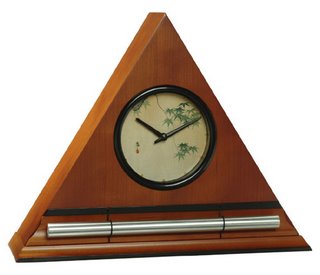 Chime Alarm Clock & Meditation Timers - Progressive Wake-Up Clock with Natural Acoustic Chime Now & Zen’s Clock & Timer Shop
1638 Pearl Sreet
Boulder, CO 80302
(800) 779-6383
Posted in Bamboo Chime Clocks, intention, Meditation Timers, Meditation Tools, mindfulness practice, Well-being, yoga, Zen Timers
 relaxation By Julie Dugdale
You’re caught defenseless—in line at the grocery store of all places. It’s as if someone amped up the fluorescent lights by a zillion watts, and you’re trapped in the glare. As sweat trickles down your back, your heartbeat quickens. Your chest constricts like a giant fist closing around your ribs. Your upper body starts shaking, but you can’t take a breath to steady yourself—there’s not enough air. The shopping carts, magazine racks, and aisles start to contort as dizziness warps your senses. Maybe I’m having a heart attack, you think. Suddenly, you’re 100 percent sure you’re dying, right there in the checkout lane.
Sound at all familiar? You’re not dying—you’re having a panic attack. This sudden flash of terror, which can last 10 minutes, is a hallmark of panic disorder—one of a half-dozen forms of anxiety. Every year, anxiety disorders wreak havoc on 40 million Americans, lasting six months or longer and evoking fear or uncertainty that makes it difficult to function in daily life. As such, anxiety is closely related to depression: Almost 50 percent of patients diagnosed with depression are also diagnosed with some form of anxiety. (See “What Kind of Worrier Are You?” on page 34 for a complete list of anxiety disorders.)
Are you at risk for anxiety disorders? First, check your family history: According to the National Institute of Mental Health, the tendency toward panic episodes is hereditary. “All of us are different biologically, and some of us are more prone to anxiety,” says James Gordon, MD, founder and director of the Center for Mind-Body Medicine in Washington, DC, and author of Unstuck: Your Guide to the Seven-Stage Journey Out of Depression (Penguin, 2009). Life experiences play a role, too. “Some of us are more vulnerable because we’re subject to circumstances—like being in a war—where an anxiety attack might be triggered.” Gordon says. Of course, it doesn’t take war to bring on an attack. Family conflict, money problems, job loss—all of these events can set off anxiety.
 relax Problem is, when it comes to combating anxiety in our culture, we tend to gloss over the circumstances, Gordon says. There is a tendency to focus on snuffing out the symptoms with medication, rather than rooting out the actual causes. Conventional treatments like benzodiazepines (potent anti-anxiety drugs), beta-blockers (heart medications that treat physical symptoms of certain anxiety disorders), and SSRIs (selective serotonin reuptake inhibitors, or antidepressants, including Prozac, Paxil, Zoloft, Lexapro, and Celexa) work at the surface, not at the source. These medications do not cure anxiety; they get the symptoms under control temporarily by altering brain chemistry. Side effects can range from nausea and jitteriness to sexual dysfunction and addiction. “Instead of falling into the narrowness of a medical model where you identify symptoms and apply treatment to those—you have to ask what is going on in your life,” Gordon says. “You have to look at what is making you the most anxious. It’s about finding a state of balance rather than tranquilizing yourself.”
Here, we identify some therapies to help you reach the origin of your worries. Along the way, you’ll need strategies to take the edge off your stress without medicating. We’ve got you covered there, too.
Breathe deep
 deep breathing Mastering your breathing is key to controlling anxiety. Anxious people tend to breathe shallowly, staccato-like, from the chest. Instead, find a quiet space and make a concerted effort to breathe long and deep through the nose and mouth so your belly goes in and out. “With coherent breathing and smooth inhalation and exhalation, you’re actively calming your state,” says Philip Muskin, MD, professor of clinical psychiatry at Columbia University. “The built-in effects of slow abdominal breathing counter the effects of hyperventilation. You can use this technique to re-center yourself.” Try five breaths per minute for five minutes, several times a day.
Stretch out
A significant body of recent research, including a 2010 review published in the journal American Family Physician, shows that yoga is an effective anti-anxiety practice because it improves mood, attention span, mental focus, and stress tolerance. The benefits of Sudarshan Kriya yoga (SKY)—a form of yoga that focuses on cyclical breathing—were detailed in a 2005 article in the Journal of Alternative and Complementary Medicine. According to the report, SKY helped survivors of the tsunami in Southeast Asia and the wars in Bosnia and Iraq overcome post-traumatic stress disorder, depression, anxiety, and insomnia. Try practicing 30 minutes of yoga per day.
Energize and balance
Qigong, a Chinese form of meditation that combines slow, deliberate breathing and graceful movement, is believed to ward off anxiety by revitalizing and centering energy. Similarly, the Japanese massage practice of reiki targets energy: A practitioner lightly places his palms on your chakras (major energy points), boosting the flow of internal energy. The New York–based Center for Reiki Wellness and Hypnosis recommends at least four reiki sessions, either weekly or biweekly, for the best results.
Mind your kidneys
From a Chinese medicine perspective, anxiety is related to kidney function, explains Rebecca Wood, author of the New Whole Foods Encyclopedia (Penguin, 2010). Specifically, poor kidney function throws off your qi (energy), directly resulting in anxiety. “The kidneys are your grounding, your anchor,” Wood says. Keep your kidneys healthy, she advises, by eating foods that support kidney function, such as root vegetables, seaweed, beans, meat, fish, and poultry. (For more natural ways to boost kidney health, read “Keep Your Kidneys Healthy” at naturalsolutions mag.com.)
 calming lavendar Try a supplement regime Targeted supplements can help ease your anxiety. Here are a few nutritional and herbal remedies to try. But remember, supplements should be taken only after consulting a practitioner or physician, especially if taken in conjunction with other anxiety medications, as some interactions could be harmful.
GABA
One of the main objectives in treating anxiety is to enhance the activity of GABA, a neurotransmitter responsible for relaxation and reducing worry. GABA is also an amino acid, and low levels of GABA can increase tendencies toward tension, depression, and sleeplessness. Upping your GABA can slow breathing, relax muscles, and shift mood.
Take: 100 to 500 mg two to three times daily.
Inositol
This nutrient balances serotonin, a neurotransmitter that affects mood. According to Richard Bloch, PhD, professor of psychiatric medicine at East Carolina University, high doses of inositol reduce panic attacks, with side effects comparable to SSRIs.
Take: 12 to 18 grams in tablet or powder form daily. Start with a lower dosage to see how your body reacts.
Kava
A native of the South Pacific, kava has been used for thousands of years to help anxiety. Its root was traditionally chewed or ground into a drink and is still valued today for its sedative and muscle-relaxant properties. “Kava is found to help generalized anxiety disorder,” Bloch says, referring to chronic anxiety characterized by constant and exaggerated worry, tension, and fatigue. “If it did not have unpredictable, although rare, liver complications, it would be a great way to avoid medical visits. But because of the possible dangers of side effects, it should be used with physician monitoring.”
Take: 300 mg as capsules, tinctures, or powder or 200 mg of kavalactones, the active ingredient taken directly from the lateral roots.
L-theanine
This amino acid found in green tea enhances activity in the GABA neurotransmitter. A 2005 article published in Alternative Medicine Review suggests that L-theanine increases alpha brain waves—those that keep you alert yet relaxed—just 40 minutes after ingesting.
Take: 200 mg two to three times daily, or drink three cups of tea.
Magnesium
Magnesium is one of the most common deficiencies in the American diet, says registered herbalist Roy Upton, RH, president and CEO of the American Herbal Pharmacopoeia. According to Australian and New Zealand Journal of Psychiatry, 68 percent of American adults get less than the recommended daily allowance of magnesium. The same study showed that symptoms of both depression and anxiety decrease when dietary intake of magnesium increases.
Take: 650 mg daily.
Valerian
Known as “nature’s valium,” valerian has a tranquilizing effect on neurotransmitter activity in the brain, creating an overall calming sensation similar to the drug, minus the unwanted side effects.
Take: 50 to 100 mg two to three times each day.
Talk it out
A 2008 study of patients with panic disorder showed that more than 70 percent had fewer symptoms (fear, heart palpitations, shortness of breath) following 12 weeks of psychodynamic psychotherapy, aka talk therapy. Talking about what’s bothering you can help you identify negative thinking patterns—and, eventually, reshape those patterns. “Talk therapies work pretty well for anxiety disorders,” says Muskin, “because you’re involved with another professional who’s talking to you and with you.”
Confront it
A next step might be cognitive behavioral therapy (CBT), a more specific type of talk therapy through which you learn to change the way you react to situations that may induce panic and anxiety. According to the National Association of Cognitive-Behavioral Therapists, CBT is “based on the idea that our thoughts cause our feelings and behaviors, not external things like people, situations, and events.” Thus, we can change our reactions even if the external situations remain the same. Muskin cites a CBT technique called “gradual exposure,” which introduces the patient to panic-inducing situations in increasing doses, eventually desensitizing the person to the fear. “For example: For a fear of bridges, you’d start by talking about bridges, then looking at them, and then, eventually, walking over a bridge.”
Let it go
 let it go Hypnotherapy can be used in conjunction with cognitive behavioral therapy to further reduce anxiety, as it’s based on a similar premise of changing the way you perceive events or situations. Here’s how it works: A certified clinical hypnotherapist (find one at natboard.com) guides you toward a deep state of focused relaxation, introducing mental imagery that suggests a symptom-free scenario. Your body relaxes as your heart rate and blood pressure slow down, and your mind becomes more engaged with the suggestions the therapist offers, enabling you to “disassociate” from the thoughts responsible for your anxiety. You never lose consciousness, which theoretically allows you to reflect on what you were able to let go of while coming out of the trance state.
Remember: Whether you’re a chronic worrier or only occasionally panic-ridden, anxiety can take its toll. Before you feel the next attack coming on, come up with your own plan for relaxation—being prepared is your best defense.
WHAT KIND OF WORRIER ARE YOU?
Anxiety comes in many forms. It may be constant or fleeting, uncomfortably acute or very broad. Here, we break down the major variations, courtesy of the experts at the National Institute of Mental Health.
If you’re one of 6.8 MILLION AMERICANS who is currently dealing with generalized anxiety disorder,
You’re feeling: Worried about everything and nothing, all the time; fatigued; and frustrated.
If you’re one of 15 MILLION AMERICANS who have social phobia,
You’re feeling: Extremely self-conscious in social situations, always worried that others are watching and judging you.
If you’re one of 2.2 MILLION AMERICANS who is plagued by obsessive-compulsive disorder,
You’re feeling: Compelled to complete certain rituals and check up on circumstances, like a locked door; intensely afraid of germs and dirt; the need to wash your hands over and over.
If you’re one of 7.7 MILLION AMERICANS who suffers from post-traumatic stress disorder (PTSD),
You’re feeling: On edge and hypervigilant for no reason; irritable; isolated or emotionally numb; unable to concentrate due to pervasive and frightening flashbacks and memories.
If you’re one of 6 MILLION AMERICANS who have panic disorder,
You’re feeling: Terrified about when your next panic attack will occur and afraid to return to the spot of your last one. Twice as many women as men are affected by this disorder; about one-third develop agoraphobia, or a fear of being in a place where escape might be difficult.
COPING WITHOUT MEDS
 coping without meds
10 more tips to minimize your stress naturally, from the Anxiety Disorders Association of America
1. Step back from the problem. Find another activity that helps you relax.
2. Don’t skip meals. Have snacks on hand to make sure your blood sugar is stable. The brain uses more sugar than any other organ, and fluctuating blood-sugar levels translate to an unbalanced mental state.
3. Sleep as much as you can. Your body needs more rest when it’s stressed, as reacting to anxious feelings eats up energy, and sleep is the body’s natural means of restoring that energy.
4. Count to 10 slowly. Repeat.
5. Accept that you can’t control everything.
6. Be OK with your best, even if it’s not perfect.
7. Seek out humor, and let yourself laugh.
8. Get involved in your community. Find a support network.
9. Write in a journal when you’re feeling anxious, and look for patterns.
10. Talk with your family and friends. Don’t keep it inside.
One of the ultimate Zen like experiences is waking-up from a great slumber refreshed and energized. Your mind and body are harmoniously one, both alert and focused. Having a refreshed mind and body are two keys to a natural and Zen lifestyle. Waking up in the morning should not be a loud and abrupt awakening, but rather it should be a peaceful positive experience. The right natural alarm clock can transition your deep and tranquil sleep into a serene start to consciousness. Imagine a long-resonating Tibetan bell-like chime waking you up to a beautiful morning experience.
The right alarm clock can be the most beneficial investment for you. With our Now & Zen natural alarm clock you are awakened more gradually and thus more naturally. Now & Zen is focused on creating a naturalistic lifestyle, and our clocks are an example of our philosophy.
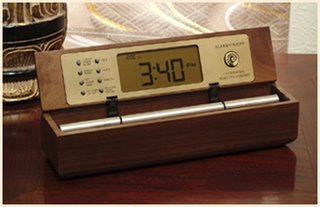 choose a gentle alarm clock with acoustic sounds to reduce stress Now & Zen’s Peaceful Chime Alarm Clocks
1638 Pearl St.
Boulder, CO 80302
(800) 779-6383
Posted in Well-being
 Shin-hanga print, Summer Beauty by Hashiguchi Goyo, 1920 We have created the perfect yoga and meditation timer! Our Digital Zen Alarm Clock® has been specifically designed with yoga practitioners in mind. The clock can be set to produce a beautiful Tibetan bell-like chime repeatedly at any set interval.
We know that many yoga practitioners use beeping kitchen timers to signal periodic position changes. However, the Digital Zen Alarm Clock’s acoustic pure-tone chime is more appropriate for use in spiritual practices such as yoga. The chime’s B tone has been hand tuned using the ancient Pythagorean method — the clock’s tone is the same as that produced by tuning forks used by musical therapists. And not only does the Digital Zen Alarm Clock sound beautiful, it looks beautiful as well. Its solid hardwood case is an attractive addition to an altar or mantle.
 Bamboo yoga and meditation timer, designed especially for yoga practitioners Because of the popularity of our original Zen Alarm Clock we were flooded with requests for a digital version that can be used as a countdown and interval timer.
Now & Zen’s Yoga Timer Shop
1638 Pearl Street
Boulder, CO 80302
(800) 779-6383
Posted in Meditation Timers, Meditation Tools, Now & Zen Alarm Clocks, Progressive Awakening, Well-being, Yoga Timer, Yoga Timers by Now & Zen
 winter self massage During winter, nature sighs deeply and burrows down for a long sleep. Like the denning bears and squirrels, use these cozy times to reduce stress. Especially in urban environments, we often become detached from this seasonal message. Continuing at a frenzied pace, we develop anxiety, high blood pressure, and digestive upset. To reduce stress, “in winter we focus a lot more on massage and nutrition,” says hydrotherapist Kristi Zimmer. Try this self-massage five minutes before bed and just after waking up in the morning: Set your Zen Chime Timer for 5 minutes. Lie on your back and make gentle circular motions around your belly with both hands, going clockwise as you breathe deeply. After five minutes of this, leave your hands on your stomach as you take 20 deep breaths, sending the breath to your organs. The deep breathing calms the body and mind, while the massage aids digestion.
adapted from Natural Solutions Magazine, January 2007 by Nora Isaacs
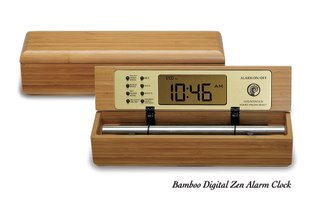 Chime Timers in Bamboo with Natural Acoustic Chimes Now & Zen’s Natural Chime Timer Store
1638 Pearl Street
Boulder, CO 80302
(800) 779-6383
Posted in Bamboo Chime Clocks, Chime Alarm Clocks, intention, Meditation Timers, Meditation Tools, mindfulness practice, Natural Awakening, Well-being, Zen Timers
 Use Mindfulness Practices to Stop Stress You’re cut off while driving. Your children erupt into a screaming fight. Or you’re five minutes away from an interview for the job of your dreams and your composure evaporates in a rush of anxiety. When life delivers adversity, stress is the common response. Your body kicks into action, preparing for a fight. The adrenal glands pump out adrenaline and noradrenaline — hormones that increase the heart rate, quicken breathing, raise blood pressure, and tense muscles. You’re ready to take on the perceived threat to your safety or well-being.
Of course, in reality we rarely run from foes or physically challenge them. As a result, we don’t burn off these powerful hormones, leaving them to “course through our bloodstream,” explains Dr. Herbert Benson, a pioneer in stress research at Harvard Medical School’s Mind/Body Medical Institute. In the short term, a pounding heart and sweaty palms can exacerbate the stressful emotions you’re already feeling. Left unchecked, this chemical mix sets you up for an array of physical and emotional problems, says Benson, including anxiety, depression, and intensified PMS and menopause symptoms.
The next time you are facing a stressful situation, stop yourself from spiraling out of control and bring yourself back to center.
Our Zen Timepiece’s acoustic 6-inch brass bowl-gong clock & timer is the world’s ultimate alarm clock, practice timer, and “mindfulness bell.”
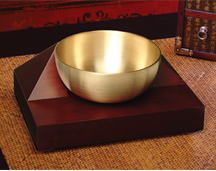 Acoustic Chime Timer and Alarm Clocks from Now & Zen - Boulder, CO
It fills your environment with beautifully complex tones whenever it strikes. In the morning, its exquisite sounds summon your consciousness into awakening with a series of subtle gongs that provide an elegant beginning to your day. Once you experience the Zen Timepiece’s progressive awakening, you’ll never want to wake up any other way. It also serves as the perfect meditation timer and ‘mindfulness practice clock’.
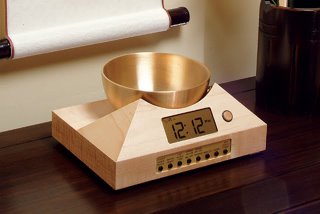 Mindfulness Practice Timer with Singing Bowl Adapted from Body + Soul, text by Erin O’Donnell
Now & Zen Meditation Timer Store
1638 Pearl Street
Boulder, CO 80302
(800) 779-6383
Posted in Bamboo Chime Clocks, Chime Alarm Clocks, intention, Japanese Inspired Zen Clocks, Meditation Tools, mindfulness practice, Now & Zen Alarm Clocks, Truth, Well-being

Serves 10
Ingredients
1 liter CalNaturale cabernet sauvignon
1/2 cup organic pomegranate seeds (or substitute splash of pomegranate juice)
1 organic navel orange, halved and slice
1 organic Granny Smith apple, cored and thinly sliced into wedges
1 1/2 tablespoons pure organic maple syrup
3 cups seltzer, chilled
1 cup ginger ale, chilled
2 tablespoons organic sugar
Splash of organic orange juice
Dash of cinnamon (optional)
Ice
In a pitcher, combine the wine, orange juice, pomegranate seeds, orange, apple and maple syrup; refrigerate for 1 hour or overnight. Stir in the seltzer and ginger ale. Serve over ice.
Freelance writer and editor Kim Wallace can be reached at kim@kimberlyloc.com
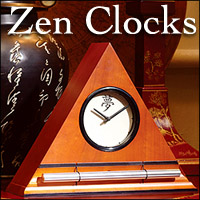 Zen Clocks and Timers Now & Zen’s Alarm Clock Shop
1638 Pearl St.
Boulder, CO 80302
(800) 779-6383
Posted in Well-being
 Mountan Meditation Mountain Meditation
Create a comfortable, stable, supported seated posture. If sitting on the floor, support your knees with pillows or blocks. Sit upright and close your eyes. Let your breath flow naturally, without manipulating it. Rest your attention on the rising and falling of your belly or chest.
Imagine a majestically tall mountain. Contemplate how solid and stable the mountain is throughout the changing seasons. At times the mountain may be clouded over, its peak covered in fog. Sometimes the mountain is assaulted with thunder, lightning, and heavy rains. Sometimes it rises into a clear blue sky or a few white puffy clouds. At times it is covered in snow, at times with lush foliage, and at other times it is barren. Throughout, it remains stable and unaffected by the changing weather or seasons. Let this stable quality of “mountainness” nourish your concentration and your ability to sit through all the varying experiences that arise while practicing this meditation.
Now feel your posture to be like a mountain. Breathing in, see yourself as a mountain; breathing out, feel stable. Some thoughts and emotions are like storms, others like sunshine. Your mind can be clouded over or clear and bright, but through it all, you can still sit solid.
adapted from Yoga Journal, by Frank Jude Boccio
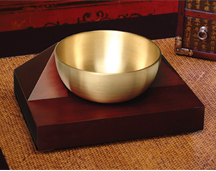 Meditation Timer with Singing Bowl Now & Zen
1638 Pearl Street
Boulder, CO 80302
(800) 779-6383
Posted in Bamboo Chime Clocks, Meditation Timers, Meditation Tools, mindfulness practice, Now & Zen Alarm Clocks, Well-being
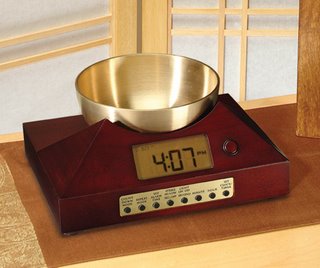 Zen Timepiece with brass bowl
Discover the healing power of sound with singing bowls, tuning forks, and other musical instruments.
Music can move us to tears, help us feel calm or comforted, or inspire us to action. The rhythmic sounds of nature (think of waves breaking on a beach) can bring us into balance. Now researchers are learning more about how music and sound directly affect the healing process.
EVIDENCE. A 2008 study at the University of Maryland School of Medicine revealed that listening to music you consider joyful for 30 minutes helps release endorphins to relieve pain and reduce stress, which can otherwise overload your immune system and lead to a host of health conditions. Another study completed last year at Seattle University in Washington showed that listening to Mozart for 12 minutes three times a week can lower systolic blood pressure by seven points.
YOUR BODY TUNES IN. Researchers say that when you listen to music and sounds, your heartbeat, breath, and brain waves begin to slow down or speed up in response to what you’re hearing. Your body syncs up with the sound, and the result can be an enhanced relaxation response—stress lifts, your heartbeat slows, muscles relax, and your body releases feel-good endorphins—or improved energy levels, depending on the rhythm.
GET STARTED. Try these ways to benefit from sound therapy:
EASE STRESS:
Use tuning forks and singing bowls
“Sonic tools” like tuning forks and singing bowls can soothe an overexcited nervous system, says Jonathan Goldman, author of The Seven Secrets of Sound Healing (Hay House, 2008). Singing bowls create a calming noise when you run a mallet around the rim, and tuning forks hum when tapped.
Try it: Use these tools as frequently as needed, says Goldman. For tuning forks, go to Healing Sounds or Biosonics. For crystal singing bowls, visit Crystal Tones. For Tibetan singing bowls, try Now & Zen, Inc., Headquarter Store, 1638 Pearl Street, Boulder, CO 80302.
RELIEVE INSOMNIA:
Listen to a healing CD
“Music is to the nervous system what nutrients are to the body,” says Joshua Leeds, author of The Power of Sound (Healing Arts Press, 2001). He designs audio CDs with music, special effects, and sounds from the natural world to enhance various activities, such as falling asleep.
Try it: See Sound Remedies or Steven Halpern Inner Peace Music.
SHARPEN YOUR MIND:
Learn an instrument
Studies show that daily practice of a musical instrument can keep the brain young and pliable. It can also help relieve tension as your body actually resonates with the soft energies of the instrument.
Try it: Find a local teacher and ask about beginner lessons. Practicing for five minutes can clear tension and a foggy mind. Use your Zen Timepiece in the morning to wake up to a singing bowl for a gentle and progressive awakening.
Our Zen Timepiece’s acoustic 6-inch brass bowl-gong clock is the world’s ultimate alarm clock, practice timer, and “mindfulness bell.”
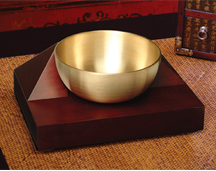 Natural Sound Alarm Clocks & Sound Therapy It fills your environment with beautifully complex tones whenever it strikes. In the morning, its exquisite sounds summon your consciousness into awakening with a series of subtle gongs that provide an elegant beginning to your day. Once you experience the Zen Timepiece’s progressive awakening, you’ll never want to wake up any other way. It also serves as the perfect meditation timer.
adapted from Natural Health Magazine July 2010, by Elizabeth Casey
 Singing Bowl Clocks by Now & Zen called The Zen Timepiece
Posted in Bamboo Chime Clocks, Chime Alarm Clocks, Goodness, Meditation Timers, Meditation Tools, mindfulness practice, Natural Awakening, Progressive Awakening, Well-being, Zen Timepiece by Now & Zen, Zen Timers
« Previous Page — « Previous Entries
Next Entries » — Next Page »
|
|
|
|